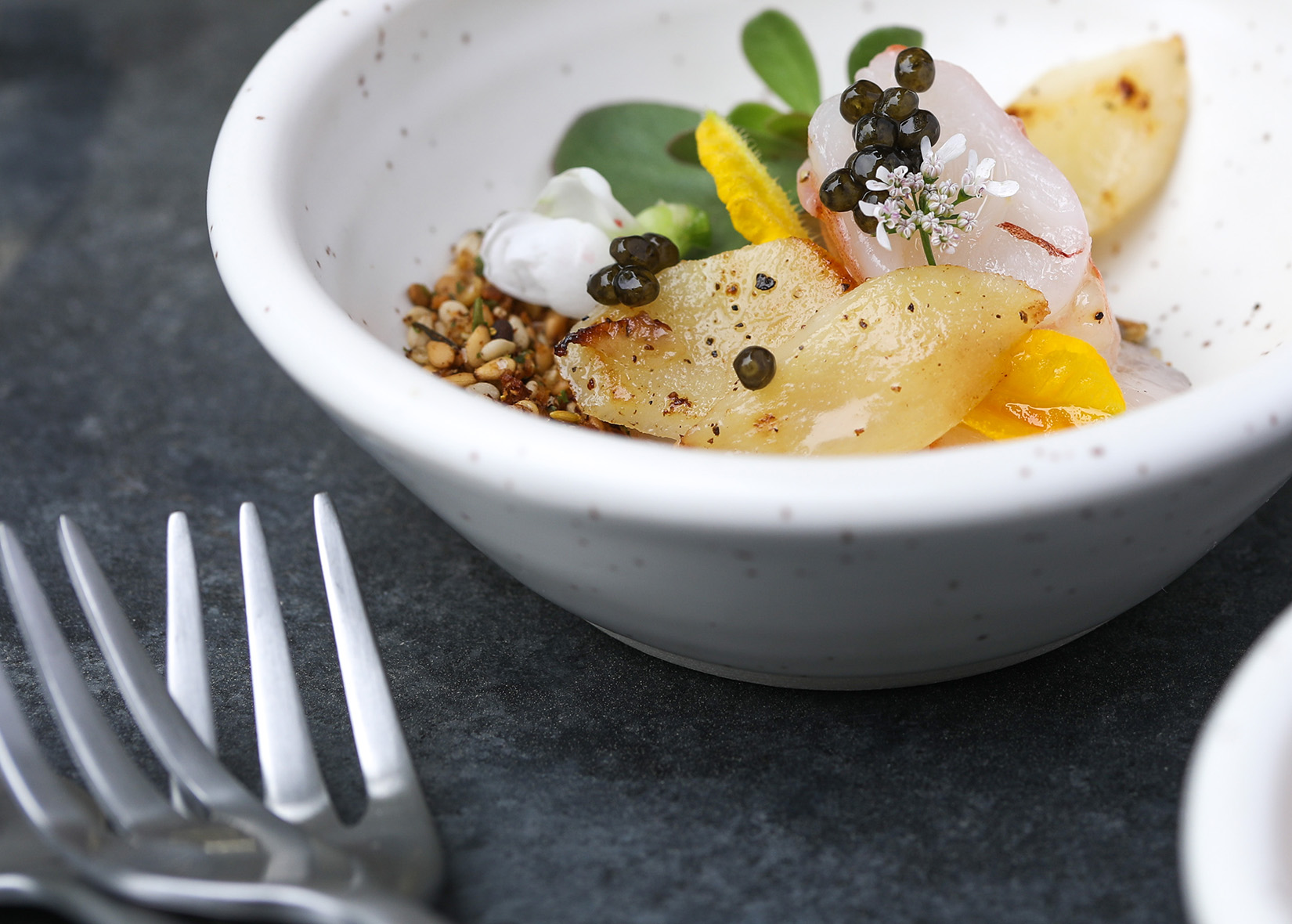Instructions
Share
For the ocean-inspired vinaigrette, combine all ingredients, except for the oils and half the limu, in a non-reactive bowl. Allow the limu to rehydrate in the base for 20 minutes. Blend the base on high for 15 seconds and strain. Slowly whisk in oils to emulsify and pour into a small mason jar with the remaining limu and Benne seeds. Allow the vinaigrette to steep for 24 hours. Shake to emulsify and adjust seasoning just prior to serving.
For the poached prawns, shell and devein the prawns, keeping the tail intact. Toss the prawns in lemon zest and sugar and marinate for 15 minutes. Meanwhile, bring a large pot of water to 140°. Place the marinated prawns, olive oil, salt, tarragon and lemongrass in a freezer bag and seal, removing as much air as possible by using the edge of the table or by water displacement. Lower the bag into the water and cook for 17 minutes, maintaining a water temperature between 132° and 137°. The cook time should be no less than 15 minutes and no more than 30 minutes. While the prawns are cooking, prepare an ice bath. Remove the bag from the hot water and immediately chill in the ice bath to arrest cooking. Remove the prawns from the olive oil and reserve. This component may be done up to eight hours in advance.
For the Sonoma sand, preheat oven to 275° and heat seasoned water in a stock pot over medium-high heat. Pierce the sunchokes all over and steam or simmer in the stock pot until completely cooked through. Remove from the pot. When the sunchokes have cooled enough to handle, peel by hand, keeping the skins as in tact as possible. Reserve the flesh for another purpose. Place the skins on an oiled baking sheet and bake in a low oven until they just begin to crisp and color (approximately 15-20 minutes). Remove from the oven and increase the oven temperature to 300°.
While the sunchoke chips are cooling, rub olive oil into the cooked quinoa, season with salt and pepper and toast in a 300° oven on an oiled baking sheet until crisp (approximately 15-20 minutes). Cool and reserve. Crush the sunchoke chips with the bottom of a heavy pan or the side of a chefs knife (do not pulverize completely, the goal is to add texture). Combine crushed sunchoke chips, toasted quinoa and all remaining ingredients. Store in an air tight container. Sand will keep well for up to two weeks.
For the salsify, prepare an acidulated bath with lemon juice and spring water in a non-reactive bowl. Peel the tough outer skin from the salsify, then quickly slice the root thinly on the bias and reserve in the bath to prevent discoloration. Bring a small pot of seasoned water to a boil over high heat. Blanch the salsify for two minutes, drain with a slotted spoon and reserve on paper towels.
Just prior to serving, season the blanched salsify with salt and pepper. Bring a small sauté pan to medium-high heat, add 2 teaspoons of grapeseed oil, and quickly sauté the salsify. Reserve.
Spoon the sand onto six plates and place sautéed salsify on top. Slice the prawns on the bias, toss in a bowl with the vinaigrette and arrange over the salsify. Garnish with Jordan Chef’s Reserve Caviar, blossoms from the garden and purslane.

